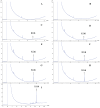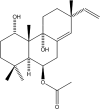Wound healing potential of mouth gel containing isopimarane diterpene from Kaempferia galanga rhizomes for treatment of oral stomatitis
- PMID: 39713130
- PMCID: PMC11662896
- DOI: 10.7717/peerj.18716
Wound healing potential of mouth gel containing isopimarane diterpene from Kaempferia galanga rhizomes for treatment of oral stomatitis
Abstract
Background: Oral ulcers have an impact on 25% of the global population including patients who are suffering from chemotherapy and radiotherapy treatments. Kaempferia galanga L. has been traditionally used for treatment of mouth sores and tongue blisters. However, the wound healing study of isopimarane diterpenes isolated from K. galanga is still limited.
Objective: This study aims to evaluate the wound healing potential of 6β-acetoxysandaracopimaradiene-1α,9α-diol (KG6), a compound isolated from Kaempferia galanga, by examining its biological activities. Additionally, we investigate the physicochemical and biological properties of (KG6) in formulated mouth gels.
Methods: The KG6 mouth gels at 0.10%, 0.25% and 0.50% w/w were formulated using sodium carboxymethylcellulose as a gelling agent, and their physicochemical and biological stabilities were assessed through a heating-cooling acceleration test. The quantification of KG6 contents in KG6 mouth gels was determined using gas chromatography. Both KG6 and KG6 mouth gels were evaluated for their wound healing properties including cell proliferation, cell migration, and antioxidant activity (H2O2-induced oxidative stress) in human gingival fibroblast (HGF-1-ATCC CRL-2014) (HGF-1). In addition, the anti-inflammatory activity against nitric oxide (NO) production was investigated in macrophage cells (RAW 264.7).
Results: After KG6 mouth gels were incubated under heating-cooling acceleration condition, the physicochemical properties of the KG6 mouth gels remain stable across various parameters, including appearance, color, smell, texture, pH, viscosity, separation, and KG6 content. The biological studies indicated that the KG6 compound possessed good wound healing potential. The 0.50% KG6 mouth gel exhibited marked anti-inflammatory effect by inhibiting NO production with an IC50 of 557.7 µg/ml, comparable to that of Khaolaor mouth gel, a positive control. The 0.25% KG6 mouth gel increased HGF-1 cell proliferation to 101.7-103.5%, whereas all formulations of KG6 mouth gel enhanced HGF-1 cell migration to 94.7-98.9%, higher than Khaolaor mouth gel (73.5%). Moreover, 0.50% KG6 mouth gel also showed a good antioxidant effect under H2O2-induced oxidative stress.
Conclusion: This study substantiates the significant biological activities related to the wound healing property of 0.50% KG6 mouth gel for treatment of aphthous ulcers and oral stomatitis from chemotherapy and radiotherapy treatments.
Keywords: KG6; Kaempferia galanga; Mouth gel; Wound healing.
© 2024 Iadnut et al.
Conflict of interest statement
The authors declare that they have no competing interests.
Figures





Similar articles
-
Wound healing properties of pharmaceutical gel containing isopimarane diterpene isolated from Kaempferia galanga L.J Ethnopharmacol. 2022 May 10;289:115052. doi: 10.1016/j.jep.2022.115052. Epub 2022 Jan 29. J Ethnopharmacol. 2022. PMID: 35101569
-
Anti-inflammatory and wound healing effects of mouth gel containing kaempulchraol K from Kaempferia galanga rhizomes.J Ethnopharmacol. 2024 Apr 24;324:117762. doi: 10.1016/j.jep.2024.117762. Epub 2024 Jan 14. J Ethnopharmacol. 2024. PMID: 38219883
-
Anti-inflammatory effect of isopimarane diterpenoids from Kaempferia galanga.Phytother Res. 2020 Mar;34(3):612-623. doi: 10.1002/ptr.6549. Epub 2019 Nov 21. Phytother Res. 2020. PMID: 31755164
-
Anti-inflammatory and wound healing effects of gel containing Kaempferia marginata extract.J Ethnopharmacol. 2019 Aug 10;240:111964. doi: 10.1016/j.jep.2019.111964. Epub 2019 May 18. J Ethnopharmacol. 2019. PMID: 31112755
-
Phytochemistry, pharmacological activities and uses of traditional medicinal plant Kaempferia galanga L. - An overview.J Ethnopharmacol. 2020 May 10;253:112667. doi: 10.1016/j.jep.2020.112667. Epub 2020 Mar 2. J Ethnopharmacol. 2020. PMID: 32061673 Review.
References
-
- Aroonrerk N, Kamkaen N. Anti-Inflammatory activity of Quercus infectoria, Glycyrrhiza uralensis, Kaempferia galanga and Coptis chinensis, the main components of thai herbal remedies for aphthous ulcer. Journal of Health Research. 2018;23(1):17–22.
MeSH terms
Substances
LinkOut - more resources
Full Text Sources

